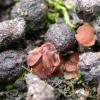
04-01-2026 17:45
 Stephen Martin Mifsud
Stephen Martin Mifsud
I was happy to find these orange asmocyetes which

03-01-2026 13:08
Niek SchrierHi all,We found groups of perithecia on a Lecanora

29-12-2025 17:44
Isabelle CharissouBonjour,J'aimerais savoir si d'autres personnes au

02-01-2026 17:43
MARICEL PATINOHi there, although I couldn't see the fruitbody, I

01-01-2026 18:35
Original loamy soil aside a artificial lake.The co

31-12-2025 19:27
Collected from loamy soil, at waterside (completel
 salut a tous,
salut a tous,in case of an article about pseudombrophila bulbifera, i'm in search of informations concerning ecology and distribution. has anybody made collections of this rare taxa, one of only two pseudombrophila-species with globose spores?
if someone has the diagnose of boudiers ascophanus dentatus (Bull. Soc. Mycol. France 13) i would be very thankful!!
Cordialement
Dirk

schöner Fund. Hast du die Pseudombrophila Arbeit von van Brummelen?
Die Arbeit von Boudier findest du hier:
Du zweifelst wohl an deiner Bestimmung? Die beiden Arten unterscheiden
sich nur durch die Sporengröße (über 10 oder unter 10 µm für denutata) und Ps. bulbifera
soll ein Sclerotium habe, was ich bei meinen Fund aber auch nicht so recht
finden konnte.
Gruß Peter

Moyne G. 2008. Pseudombrophila bulbifera (E.J. Durand) Brumm. Un champignon coprophile peu commun. Bulletin mycologique et botanique Dauphiné-Savoie, 191, p. 45-49.

On article about coprophious mushrooms I'm always interested. One can not unfortunately have any magazines. The love of money is not enough there. ;-)
Best regards Peter
PS: Mistake on my part. I meant Nicolas. Nobody is perfect. ;-)
Rene your proposal is not bad either, which has everything you as a PDF, you can take in the computer.
Thank you Peter
Je vous adresse, en privé, à cause du poids, un scan de la publication de Brummelen, répondant à votre demande.
Je signale toutefois qu'il y a, dans ce genre, et contrairement à ce que vous avez indiqué, deux espèces qui possèdent des ascospores sphériques. la deuxième étant P. dentata, sur excréments de lapin !!
René



